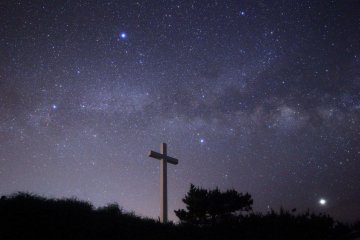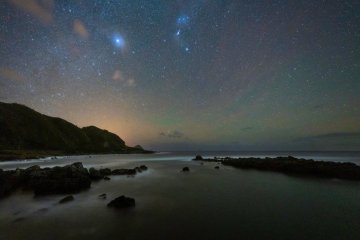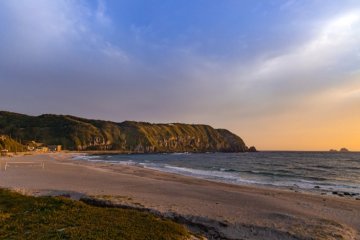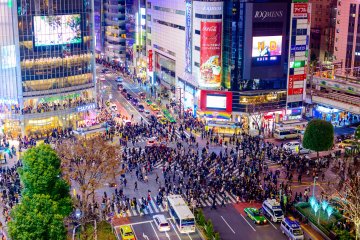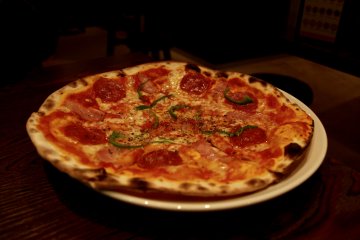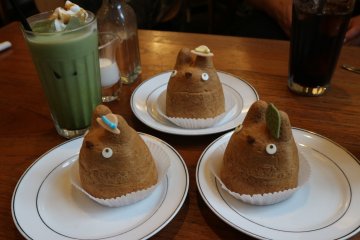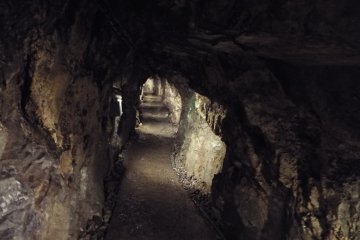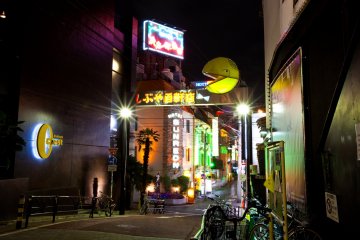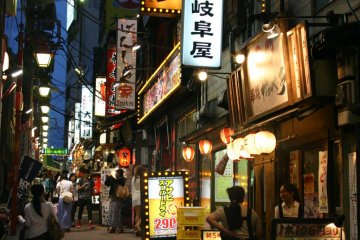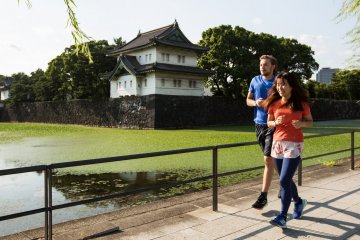Leave Tokyo’s city streets behind, and embark on a seaside adventure on the enchanting island of Kozushima. Unbeknownst to many, Tokyo Prefecture extends far beyond mainland Japan and encompasses a number of tiny islands.
Kozushima, which translates to “the island where the gods gather,” is a roughly 18.25-18.5 km2 island situated 170-180 km south of central Tokyo. According to legend, the god Kotoshironushi no Mikoto used Kozushima as a godly meeting place to discuss the creation of the Izu Islands. Today, this island is renowned for its pristine beaches, crystal blue waters, and rocky coastlines. Given its paradise-esque environment, the island is a hotspot for watersports, such as snorkeling and diving, as well as land-bound activities, like hiking and barbequing. Kozushima is also famous for its captivating night skies and is designated as Dark Sky Island for its preservation efforts.
The nourishing environment supports both relaxation and adventure, making Kozushima a favorite destination for a variety of people. Also, with its eco-tourism offerings, including hiking, diving, swimming, and snorkeling, and relatively isolated location, the island is an off-the-beaten-path destination where sustainable tourism thrives.
Follow us on a three-day excursion across this island, and discover Tokyo’s unexpected wonders!
Itinerary outline
Day 1
→ Lunch at Yocchare Center → Miura Bay Observatory → Matsuyama Promenade and Observatory → Tako Bay Beach and Tako Marushima → Hyuga Brewery → Lodging and dinner at Sumiremaru
Day 2
→ Shopping at Ishikura Stone Warehouse → Lunch at `AILANA → Mt. Tenjo Hiking → Dinner at Kozushima Ryugu → Stargazing Tour with Full Earth
Day 3
→ Akasaki Promenade → Maehama Beach → Monoimina-no-mikoto → Arima Observatory
Table of contents
Day 1
As is the case with most of Tokyo’s islands, our journey began at Takeshiba Pier in Minato Ward, which is close to Tokyo’s city center. Here, we boarded a large passenger ferry and traveled overnight for about 12 hours—arriving at Kozushima Ferry Terminal around 10am. Having slept on the boat, we were energized and ready to explore the island. After securing our rental car—which is the best mode of transportation for sightseeing in Kozushima—we headed to Yocchare Center for some locally-sourced seafood.
Yocchare Center

Since Yocchare Center is situated right next to Kozushima Ferry Terminal’s information center, Macchare Center, it serves as an ideal place to kick off your island adventure. The facility’s restaurant is located on the second floor and features a no-frills exterior lined with windows where you can watch the ocean.

Ordering is easy as there is a ticket machine located near the dining area’s entrance. After ordering, you simply pass your meal ticket to the kitchen. No speaking is necessary! The eatery’s most popular meal is its fresh fish bowl set (漬丼定食), which comes with pickled sashimi and seaweed over rice with Japanese pickles, vegetable tempura, soup, and a small piece of cooked fish. If raw fish is not to your liking, you can opt for a boiled fish with soy sauce set (金目煮付定食), fish curry set (お魚カレー定食), fried fish set (お魚フライ定食), or ginger-grilled pork set (生姜焼定食). All of the set meals cost ¥1,000.

During my visit, I chose the fresh fish bowl set, which the kitchen prepared quickly. The sashimi’s soft texture melted in my mouth, and I could tell that the fish was exceedingly fresh. The side dishes were equally delicious, and I especially enjoyed the crunch of the vegetable tempura. The meal was satiating without being too filling and perfectly set the mood for the trip ahead.
As Yocchare Center is located near Kozushima’s tourist information center (Macchare Center), we recommend that you stop by before or after your meal to pick up some maps of the area (available in English).
Details
- Address: Yocchare Center 2F, 37-2 Kozushima, Tokyo 100-0601 (Google Map)
- Business hours: 11am–2pm
- Closed: Tuesday; Jan 1-2
- Website: https://kozushima.com/shop/taberu/356/ (there is a machine-translated “Selected Language” button at the top of the page)
Miura Bay Observatory

Miura Bay Observatory is about an eight-minute drive from Yocchare Center and is situated on Kozushima’s southern coast.
After parking our car in a nearby parking area, we headed to the small, yet impressive lookout point. From the grassy area we were treated to mesmerizing views of Kozushima’s brilliant blue waters against its rugged, nature-enriched shoreline. Below, we spotted small caves carved into the coastline and watched as the shifting tide conjured frothy white waters. Given the clear weather, we could even see the silhouette of the nearby island, Miyakejima. The melody of the ever-shifting sea, coupled with the pleasant breeze, completed the awe-inspiring scene.

The area also had a Libra bench, and we soon realized that the island was decorated with these artistic constellation seats as an ode to its starry sky. In total, Kozushima has 12 benches related to the zodiac constellations at observation and star gazing spots across the island.
Details
- Address: Miura, Kozushima, Tokyo 100-0601 (Google Map)
- Business hours: always open
- Closed: always open
- Website: https://kozushima.com/kanko/umi/keikan-umi/286/ (there is a machine-translated “Selected Language” button at the top of the page)
Matsuyama Promenade and Observatory

Next, we continued our exploration of the island’s scenic landscape with a walk along Matsuyama Promenade.
Matsuyama Promenade’s trailhead is a roughly three-minute drive from Miura Observatory and is also located on the island’s southern end. This short, yet nature-filled loop follows Kozushima’s coast through verdant pine trees and offers unique views of the sea through their pointed branches. Aside from the picturesque journey, the trail’s main point of interest is Matsuyama Observatory.

The lush environment contrasted our impressions of a seaside walk, and the enveloping canopy created a cozy stroll. Though as we approached the observatory, the trees overhead thinned and granted vistas of the expansive ocean.

From this vantage point, we were once again hypnotized by the juxtaposition of the blue tide against the island’s majestic form. As the sun warmed my cheeks, I took a moment to close my eyes and immerse myself in the waves’ songs.
From Matsuyama Promenade’s starting point, you can also walk 0.7 kilometers to Tako Bay or commit to over three-kilometer hikes to Kozushima’s Harbor and town area.
Details
- Address: Soshiro, Kozushima, Tokyo 100-0601 (Google Map)
- Business hours: always open
- Closed: always open
Tako Bay Beach and Tako Marushima

As touched upon above, Tako Bay is relatively close to Matsuyama Observatory and takes about 11 minutes on foot or two minutes by car. Tako Bay rests at the foot of Mt. Tenjo and is a beloved swimming spot popular for its transparent, azure waters and encircling cliffs. Since the area is the site of Miura Fishing Port, it is also home to a number of small ships—painting a charming picture of seaside life.

The scenery also encompasses the mystical Tako Marushima, which is a tiny, nature-touched island just off the beach’s shoreline, and during low tide, you can even walk across this small landmass.

Thus far, we had only admired Kozushima from elevated points. At Tako Bay, we descended to sea level once more and enjoyed a more intimate experience of the island’s landscape. Upclose, the coastline’s rugged appearance was more pronounced and further extenuated by the shadow’s of the late afternoon sun. The rise and fall of the tide upon the shore was spell-binding and complemented the grand scenery. Since the temperature was a little too cold for swimming, we simply relaxed on the shore and watched nature’s display.
Details
- Address: Kozushima, Tokyo 100-0601 (Google Map)
- Business hours: always open
- Closed: always open
- Website: https://kozushima.com/kanko/umi/beach/9533/ (there is a machine-translated “Selected Language” button at the top of the page)
Hyuga Brewery

As the sun kissed the horizon, we headed back to Kozushima Village to enjoy a taste of local nightlife.
Hyuga Brewery, located approximately 10 minutes by car from Tako Bay, is Kozushima’s only brewpub. The facility’s owner, Fumiko Miyagawa, is a Kozushima native and brews one-of-a-kind beers using locally-sourced ingredients and the island’s spring water. The resulting craft beers—which range from light white ales to rich stouts—embody not only Kozushima but also Ms. Miyagawa’s passion and creativity. Here, you will find beers that incorporate elements such as ashitaba (a leafy green popular on the Izu Islands) and tengusa (a type of red algae). Hyuga Brewery also offers a number of seasonal beers, imported beers, and mixed drinks, including Kozushima’s rice liquor, moriwaka. The facility displays its brewing equipment onsite through glass windows, so you can see the machinery up close!

In terms of food, the brewery crafts elevated bar cuisine, again, using Kozushima-sourced ingredients. You can choose from a range of appetizers, which include Japanese and Western flavors, along with pasta, pizza, and a rice dish.

As darkness blanketed the island, the warm glow of Hyuga Brewery invited us inside. Upon entering, it felt like we were back in Tokyo’s metropolitan area. The minimalistically-designed dining area featured light hues with touches of greenery—creating a chic atmosphere that was further accentuated by upbeat pop music. We ordered Angie, one of the brewery’s signature beers, and Himawari, an apple cider-esque white ale. Of course, we had to try the ashitaba pizza as well. The crisp flavor of the beer was extremely refreshing, especially after a day of sightseeing, and the slightly bitter aroma of the ashitaba paired perfectly with the salty cheese.
While Hyuga Brewery does not have a parking lot, it is easily accessible on foot within the village.
Details
- Address: 142-2, Kozushima, Tokyo 100-0601 (Google Map)
- Business hours: 5:30pm–10pm
- Closed: Tuesday-Thursday
Sumiremaru

Sumiremaru is a quaint guest house situated on the southern outskirts of the village and thus, acts as a great base for your exploration of Kozushima. The accommodation is home to five tatami-floored rooms, as well as shared bathrooms and shower facilities with all the necessary amenities. If you opt for a stay with meals, the facility prepares both breakfast and dinner, which you enjoy in the communal dining area. The guest house is also charmingly decorated with dozens of adorable frog figurines and decor—giving it a homey and playful feel.

After enjoying a drink at Hyuga Brewery, we walked about 15 minutes to Sumiremaru. In typical Japanese fashion, we removed our shoes in the guest house’s entryway before entering. The wooden exterior and lived-in touches truly made it feel like someone’s home, and the intoxicating aromas of our dinner immediately caught my attention. Thus, after familiarizing ourselves with our rooms and dropping off our luggage, we immediately reconvened in the dining room. To our delight, the table was laid with an impressive and beautifully-plated spread of Western-style dishes and island delicacies. As we recounted the day’s adventures, we enjoyed Japanese fried chicken (karaage), sashimi, boiled red snapper, fish and vegetable shabu shabu (a type of Japanese hot pot), tofu, macaroni salad, and ashitaba pound cake for dessert. The meal was both exceptionally delicious and filling.

With full stomachs, we retired to our tatami rooms, which were blends of Japanese and Western designs, and, after washing up, fell asleep quickly to the quiet sounds of the island.

During our two-day stay, we also enjoyed lovely breakfasts—one traditionally Japanese and one Western—that energized us for the day’s activities.
Details
- Address: 1553 Kozushima, Tokyo 100-0601 (Google Map)
- Check-in: 12pm
- Checkout: 10am
- Closed: always open
- Website: https://kozushima.com/yado/minshuku/1147/ (there is a machine-translated “Selected Language” button at the top of the page)
Day 2
Ishikura Stone Warehouse

Our second day in Kozushima started with some shopping at Ishikura Stone Warehouse. This souvenir shop is located in the village’s center and sells a variety of locally made goods, such as cups, bags, figurines, socks, keychains, and earrings. While these colorful items make for excellent souvenirs, the facility’s most uniquely Kozushima offering is its obsidian products.

Obsidian is a type of igneous rock formed when lava cools quickly. Given its volcanic activity in the past, Kozushima is rich in obsidian, and you can see striations of this black rock interwoven into some of the island’s cliff sides. Obsidian is regarded as a power stone that increases concentration, helps improve academic performance, wards off evil spirits, and offers protection. At Ishikura, you can purchase Kozushima-formed obsidian wares, including stones, chopstick holders, and jewelry.

True to its “Stone Warehouse” name, the facility's exterior and interior are primarily composed of large gray bricks. We first perused the quirky collection of miscellaneous products, before turning our attention to the obsidian items.

The stone’s midnight rich color interspersed with white speckles from slight crystallization reminded me of the night sky—which is highly appropriate on Kozushima. So, after much contemplation, I decided to purchase a small piece of obsidian to bring a piece of Kozushima home with me.
Details
- Address: 985 Kozushima, Tokyo 100-0601 (Google Map)
- Business hours: 9am–5pm
- Closed: first and third Wednesday of the month; New Year’s Day
- Website: https://kozushima.com/shop/kau/miyage/1015/ (there is a machine-translated “Selected Language” button at the top of the page)
`AILANA

Thus far, we had primarily dined on the blessings of the sea. So for lunch, we decided to stop by `AILANA—a Hawaiian-themed burger joint!
`AILANA, also situated in Kozushima Village, is a short six-minute walk from Ishikura Stone Warehouse. The restaurant’s owner used to live in Hawaii and now brings Hawaiian vibes and American soul food to Kozushima through his eatery’s island decor and authentic burger menu. Here, you can enjoy classic hamburgers and cheeseburgers with 100% grass-fed beef topped with lettuce, onions, and ketchup. The `AILANA double cheeseburger—complete with a thick slice of bacon and two patties—is perfect if you are feeling extra hungry. Aside from its hamburgers, `AILANA also sells flavorful chicken sandwiches and refreshing passion fruit, mango, and guava juices.

As the dining area is small with only three tables—a one-seater, five-seater, and six-seater—please be mindful that it may be full during lunchtime. If that is the case, you can always order takeout!

Since we had a long day ahead, I ordered the `AILANA burger with a side of fries and mango juice. While the kitchen prepared my order, I relaxed in a seat by a window and watched the ocean as Hawaiian melodies played overhead—simultaneously enjoying two islands at once. Soon, intoxicating aromas scented the air, and my meal was ready. The sizable burger was juicy and full of savory flavors, which balanced wonderfully with the silky-textured and not too sweet mango juice.
Details
- Address: 667 Kozushima, Tokyo 100-0601 (Google Map)
- Business hours:
- Lunch: 11am–2pm (LO 1:30pm)
- Dinner: 6pm–10pm (LO 8:30pm)
- Closed: always open
- Website: https://kozushima.com/shop/taberu/10473/ (there is a machine-translated “Selected Language” button at the top of the page)
Mt. Tenjo Hiking

With maximum energy from the hearty burgers, we headed to our next stop—Mt. Tenjo.
Mt. Tenjo, situated roughly at the island’s heart, is about 572 meters above sea level and has long been worshiped by islanders. The mountain has a trapezoid-esque shape and its flat summit is home to a diverse range of geological features, such as deserts and ponds.
The roundtrip trek, plus exploration time, generally takes between four to five hours. So, be sure to plan accordingly, and leave yourself plenty of daylight. Also, please bring your own water to stay hydrated as there are no vending machines on the mountain. Mt. Tenjo has two trekking paths—Shiroshima and Kuroshima. Locals commonly follow Kuroshima to the summit and then take Shiroshima during their descent. If you travel by car and park near Kuroshima’s trailhead, please note that Shiroshima’s trailhead is about a 20-minute walk away.

With the sun shining brightly, we began our ascent on the Kuroshima trekking path. The trail was primarily surrounded by short plantlife and thus, offered unobstructed panoramas of Kozushima and the glittering sea beyond.

Given the rather steep ascension, we were happy to stop periodically to enjoy the expansive views and refresh in the cool mountain breeze.

Once we reached the summit, we visited a number of the mountain’s iconic sights. Our first stop was Sendaiike Pond. This geological depression formed in one of Mt. Tenjo’s craters and fills with rainwater, resulting in a natural pond. Although the pond was partially dry when we visited, it still buzzed with dragonflies and offered lovely views of the sloping landscape.

Next, we visited Omotesabuku, one of the mountain’s desert areas. The rocky scenery and white sand completely contrasted Sendaiike’s lush environment—making us feel like we had entered another world. The barren landscape encircled by foliage-clad hills made for mesmerizing visuals.

Then, we had to stop by the lookout point selected as one of the “New 100 Landscapes of Tokyo.” From this vantage point, we were granted views of Mt. Kushigamine’s peak with Tokyo’s Oshima, Toshima, Niijima, Shikinejima, and Miyakejima in the distance!

We also visited Fudoike Pond, a heart-shaped pond with a small shrine at its center, and Tenku-no-oka (Hill in the Sky), a lookout point with 360° views.

At last, we followed the Shiroshima trekking path back to its corresponding trailhead. Overall, the journey’s physicality and captivating visuals made for an enriching adventure where, for the most part, our only companions were our footsteps and the rustling leaves.
Details
- Address (Kuroshima trailhead): Kuroshima, Kozushima, Tokyo 100-0601 (Google Map)
- Address (Shiroshima trailhead): Nachi, Kozushima, Tokyo 100-0601 (Google Map)
- Website: https://kozushima.com/kankospot/yama/ (there is a machine-translated “Selected Language” button at the top of the page)
Kozushima Ryugu

After immersing ourselves in the splendor of Kozushima’s nature, it was time for dinner at Kozushima Ryugu. This refined restaurant is a true celebration of Kozushima’s gastronomy and offers seafood dishes crafted with locally-caught fish. The extensive menu includes sushi and sashimi, as well as boiled and fried fish. One of the restaurant’s recommendations is its red squid sashimi (赤いか刺身), which is made from squid caught that very day! The restaurant also sells a variety of appetizers, meat options, rice dishes, and pasta. For a full dining experience, you can also order one of the restaurant’s course meals, which typically include assorted appetizers, sashimi, a fish dish, salad, fried fish, and more. The restaurant offers a substantial drink menu of alcohol and soft drinks to pair with your meal.

Upon entering the eatery, I was immediately enamored by the dining area’s chic atmosphere. Since we had a reservation, our dinner—the red snapper course—was nearly ready.

To say that this meal was a masterpiece would be an understatement. Each dish allowed the fresh ingredients to shine and displayed both simple elegance and creativity in their preparations. We especially enjoyed the red snapper rice served in an earthen pot. The fish’s slightly sweet taste melded exquisitely with the fluffy rice. The variety of textures, flavors, and temperatures made the meal a feast for the eyes and stomach.
Please note that reservations are highly recommended.
Details
- Address: 105 Kozushima, Tokyo 100-0601 (Google Map)
- Business hours:
- Lunch: 12pm–2pm (LO 1pm)
- Dinner: 6:30pm–10pm (LO meal 8pm, LO drink 9pm)
- Closed: Thursday
- Website: https://kozushima.com/shop/taberu/330/ (there is a machine-translated “Selected Language” button at the top of the page)
Stargazing Tour with Full Earth

For the past two days we had whole-heartedly explored Kozushima’s daytime beauty. Now, it was time to witness one of the island’s most precious natural assets—its starry night sky.
In 2020, the International Dark-Sky Association designated Kozushima as a Dark Sky Island for its outstanding efforts in preserving the nocturnal environment. For our expedition, we booked a guide through Full Earth—a company that aims to intimately connect visitors with nature and promote eco-friendly mindsets. With their breadth of knowledge, passion, and insight into the best stargazing spots, local guides are the best way to enhance your experience of Kozushima’s starry sky.

Our friendly guide picked us up at 7:45pm directly from Kozushima Ryugu and drove us to Kozushima’s Heliport, one of the island’s best stargazing spots. Given the area’s purpose as a heliport, it has no visual obstructions, and luckily for us, it was a crystal clear night.
Once we exited the car and turned off all artificial lights, the night sky bloomed with life. To avoid straining our necks, we laid down on the concrete ground and watched the open skies. The inky blackness glowed with hundreds of pinpricks of light and encompassed the Milky Way’s ethereal trail, which we could see with our naked eye. On occasion, shooting stars would grace the scenery—always eliciting a thrill of excitement. With his impressive laser pointer, our guide showed us constellations, as well as other astronomical wonders. Later, he took out his full-scale astronomical telescope and positioned it so we could see Jupiter and Saturn. Looking at the planets in real time—not in a movie or on a page in a book—was a surreal experience. To put it simply, the night sky was hypnotizing, and I found myself quickly mourning the view as our tour came to an end.
There is something so indescribably beautiful about the stars, and in those moments of stargazing, my typically busy mind was filled solely with thoughts of wonderment.
Please note that during autumn and winter Kozushima can get cold and windy at night, so please dress appropriately.
Details
- Address (Heliport): Kamomeana, Kozushima, Tokyo 100-0601 (Google Map)
- Tour duration: 7:45pm–9:15pm
- Website: https://kozushima.com/shop/taiken/kakushu/434/ (there is a machine-translated “Selected Language” button at the top of the page)
Day 3
Akasaki Promenade

After pleasant dreams of mountain vistas and starry skies, we started our final morning at Akasaki Promenade, located on the island’s northern tip. This popular tourist attraction features a network of wooden walkways built upon rocky cliffs that overlook transparent, turquoise waters.

The natural cove is a picturesque spot for swimming and snorkeling with fun jumping stands and has useful amenities, such as outdoor showers (only for rinsing) and public bathrooms. However, even in the colder months, the promenade serves as a stunning vantage point to admire Kozushima’s rugged coastline and vivid water. Typically, the ocean is most vibrant in the afternoon when the sun shines brightly overhead.

Although the ocean water was warm even in the early morning, we decided to bypass swimming and simply explored the area. The complex’s close proximity to the ocean and jagged shoreline allowed us to witness up close visuals of what we had only seen from afar. The pathways followed various routes along the cliffs and thus, led to a number of unique perspectives. The area even had multiple seating areas where we could relax and enjoy the alluring scenery.
Details
- Address: Kobeyama, Kozushima, Tokyo 100-0601 (Google Map)
- Website: https://www.gotokyo.org/en/spot/261/index.html
Maehama Beach

Next, we moved even closer to the ocean with a visit to Maehama Beach, situated directly next to Kozushima Village and about a 10-minute drive from Akasaki Promenade. This area is a vacationer’s paradise, complete with 800 meters of white sand, blue waters, and surrounding vegetation-adorned cliffs. During summer, the beach is a popular place for seaside activities and watersports.

With the ocean’s breeze and waves’ symphonies, we enjoyed a leisure stroll along the shore. As I watched the tide, I felt my mind relax in tandem with its rhythmic dance.
Details
- Address: Kozushima, Tokyo 100-0601 (Google Map)
- Website: https://www.gotokyo.org/en/spot/519/index.html
Monoimina-no-mikoto Shrine

Monoimina-no-mikoto Shrine is located a short two-minute drive or 10-minute walk from Maehama Beach and is one of three shrines on the island. The shrine truly captures Kozushima’s spiritual essence and matches its reputation as “the island where the gods gather.”

This shrine is designated as Shiki-nai Myojin Taisha, which refers to shrines listed on the Engi-shiki Jinmyocho (a 10th century list of important shrines) that enshrine Myojin, which are powerful gods believed to possess miraculous abilities since ancient times. In Tokyo, there are only two Shiki-nai Myojin Taisha—Monoimina-no-mikoto Shrine and Awa-no-mikoto Shrine, also located in Kozushima.

Once we entered the complex, I was immediately drawn in by its mystical allure. The quiet grounds, interspersed with traditional structures, powerful statues, lush nature, and stone walkways, created an inviting and tranquil atmosphere. Given the abundant foliage, much of the area was decorated in leaf-patterned sunlight.

From the main shrine area, we followed a tree-sheltered pathway and then a descending staircase past two grand torii (gate) where we admired views of nearby Maehama Beach. Aside from its aesthetic appeal, the shrine was a wonderful way to connect with Kozushima’s spiritual side.
Details
- Address: 41 Kozushima, Tokyo 100-0601 (Google Map)
- Business hours: always open
- Closed: always open
- Website: https://kozushima.com/shrine/english.php
Arima Observatory

To end our Kozushima adventure, we traveled to Arima Observatory for one last view of the grand scenery. Arima Observatory is located on the island’s southwestern coast and is about a 10-minute drive from Monoimina-no-mikoto Shrine.

This observation point is best recognized for its massive white cross—called Julia’s Cross—which is a memorial to Korean Christian, Julia Ota, who after being exiled to the island for her faith, had a positive impact on Kozushima’s people through her charitable acts. The lookout point itself affords views of Kozushima Village, Kozushima Port, and Maehama Beach nestled in the island’s mountainous landscape. On exceptionally clear days, you can even see Mt. Fuji! At night, the area is also a popular stargazing spot.
Blessed with blue skies and minimal clouds, the elevated view perfectly encapsulated our Kozushima experience with its composition of lush mountains, radiant water, and touch of urbanity. Julia’s Cross’ white facade and commanding presence also stood as a powerful visual. Here, I took a moment to immerse all my senses in the landscape one last time.
Details
- Address: Kamomeana, Kozushima, Tokyo 100-0601 (Google Map)
- Business hours: always open
- Closed: always open
- Website: https://www.gotokyo.org/en/spot/750/index.html
Back to the mainland
As recounted in detail above, Kozushima is celebrated for its natural beauty, ocean views, hiking trails, starry skies, and locally-sourced cuisine, making it a must-visit for adventurers looking to experience a less trodden side of Tokyo.
Given its literal distance from the hecticness of modern life, the island’s natural wonders and relaxed atmosphere facilitated mind-calming effects, and we left feeling both physically and mentally refreshed.
Access to Kozushima
From Tokyo, Kozushima is easily accessible by ferry and plane.
Ferry
From Takeshiba Pier in Minato City, you can take a high-speed jet ferry or large passenger ferry to Kozushima Port. Please note that the frequency of the ships’ departures vary depending on the time of year, so be sure to review the ferries’ service periods before planning your trip. In terms of travel times, the high-speed jet ferry takes about four hours and the large passenger ferry takes approximately 12 hours. Both trips afford expansive ocean vistas and views of Tokyo’s islands in passing.
Tokai Kisen Co., Ltd. ferry information: https://www.tokaikisen.co.jp/en/ Reservation URL: https://tokyoislands.jp
Plane
New Central Airservice operates three flights a day between Chofu Airport in western Tokyo and Kozushima Airport. The flight time is about 45 minutes, and the scenic flight boasts hawk-eye views of Tokyo metropolis and many of its islands.
New Central Airservice: https://www.central-air.co.jp/en
Veronica Carnevale @veronica.carnevale
Fulfilling my traveler's soul!




